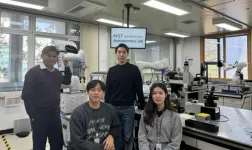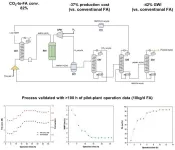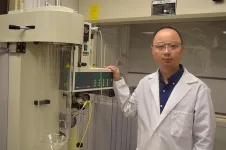(Press-News.org) PISCATAWAY, NJ – Teenagers are less likely to drink, smoke or use drugs when their parents keep tabs on their activities--but not necessarily because kids are more likely to be punished for substance use, suggests a new study in the Journal of Studies on Alcohol and Drugs.
Researchers found that, contrary to common belief, parents’ “monitoring” does not seem to boost the odds of catching their kids using substances. However, when kids simply are aware that their parents are monitoring behavior, they avoid trying alcohol or drugs in the first place.
It is the fear of being caught, rather than actually being punished.
Many studies have found that adolescents are less likely to use substances when they have parents who monitor--meaning that parents are aware of their kids’ activities, know their friends and know their whereabouts when they are not at home.
The assumption has been that monitoring works because parents are more likely to catch substance use and make sure there are consequences--grounding their kids or taking away their smartphones, for example, said William Pelham, the lead researcher on the new study. That, in turn, might keep kids from making the same mistake twice.
But it appears that assumption is wrong, said Pelham, an assistant adjunct professor of psychiatry at the University of California, San Diego.
Instead, he explained, the new findings suggest that monitoring teenagers can reduce their chances of using alcohol or drugs simply by making them think twice, whether or not parents succeed in catching them.
The results are based on survey responses from over 4,500 11- to 15-year-olds from 21 communities across the United States. Participants were asked about their substance use in the past month, including whether their parents found out about it. They also completed a standard questionnaire on parental monitoring (how often their parents knew their whereabouts or asked about their plans for the day, for instance).
Overall, 3.6% of kids said they had used alcohol or drugs in the past month, and there was no evidence that parents’ monitoring increased their likelihood of finding out about those instances.
In contrast, some kids said there were times in the past month that they planned or had the chance to drink or use drugs, but they chose not to out of fear that their parents would find out. If not for those second thoughts, Pelham’s team found, substance use would have been 40% higher in the study group as a whole.
Understanding why monitoring works is important, Pelham said, in order to give parents more specific advice on how to do it. These findings suggest that it might not be necessary to catch kids in the act of substance use: If they know their parents are keeping track of them, that might be enough.
However, that may not always apply, Pelham pointed out. This study focused on younger adolescents who were not heavy substance users, he said. When kids have more serious substance use issues, negative consequences might become a more important tool.
More broadly, the findings underscore the point that parents’ actions matter when it comes to kids’ substance use.
“Some parents think drinking or using drugs is something that kids are just going to do, no matter what,” Pelham said. “But that’s not true. Parents can make a difference.”
-----
Pelham III, W. E., Tapert, S. F., Gonzalez, M. R., Ahiarakwe, U., Patel, H., Davis, I. S., Meruelo, A., van Rinsveld, A. M., Marshall, A. T., Dick, A. S., Guillaume, M., Dowling, G. J., Baskin-Sommers, A., & Brown, S. A. (2024). How does parental monitoring reduce adolescent substance use? Preliminary tests of two potential mechanisms. Journal of Studies on Alcohol and Drugs, 85(3), 389–394. https://doi.org/10.15288/jsad.23-00297
-----
To arrange an interview with William E. Pelham III, please contact Annie Pierce, Senior Communications and Media Relations Manager, at arpierce@health.ucsd.edu or 858-249-0423.
-----
The Journal of Studies on Alcohol and Drugs considers this press release to be in the public domain. Editors may publish this press release in print or electronic form without legal restriction. Please include a byline and citation.
-----
To view the public domain, stock-photo database of alcohol, tobacco and other drug-related images compiled by the Journal of Studies on Alcohol and Drugs, please visit www.jsad.com/photos.
END
Parents’ watchful eye may keep young teens from trying alcohol, drugs: Study
2024-05-07
ELSE PRESS RELEASES FROM THIS DATE:
A triumph of galaxies in three new images from the VST
2024-05-07
FOR IMMEDIATE RELEASE
Distant, far away galaxies. Interacting galaxies, whose shape has been forged by the mutual gravitational influence, but also galaxies forming groups and clusters, kept together by gravity. They are the protagonists of three new images released by the VLT Survey Telescope (VST).
VST is an optical telescope with a 2,6 diameter mirror, entirely built in Italy, that has been operating since 2011 at the European Southern Observatory’s (ESO) Paranal Observatory in Chile. Since 2022, the telescope has been fully managed by INAF through the National Coordination Centre for VST, ...
Smart labs for bespoke synthesis of nanomaterials are emerging
2024-05-07
In the early 20th century, the development of a catalyst for ammonia synthesis by the Haber-Bosch method took more than 10,000 experiments before it was successful. The development of new materials is a time-consuming and costly process from design to commercialization. However, in recent years, researchers have been working to shorten the development period by using artificial intelligence (AI). When combined with robots, it is possible to conduct material development research 24 hours a day, 365 days a year without human ...
The commercialization of CO2 utilization technology to produce formic acid is imminent
2024-05-07
CCU (Carbon Capture & Utilization), which captures CO2 and converts it into useful compounds, is crucial for rapidly transitioning to a carbon-neutral society. While CCS (Carbon Capture & Storage), which only involves CO2 storage, has entered the initial commercialization stage due to its relatively simple process and low operational costs, CCU has only been explored at the research level due to the complexity of conversion processes and high production costs of compounds.
Dr. Lee Ung's team at the Clean Energy Research Center ...
Multisite review shows serious adverse events occur frequently in outpatient care
2024-05-06
Embargoed for release until 5:00 p.m. ET on Monday 6 May 2024
Annals of Internal Medicine Tip Sheet
@Annalsofim
Below please find summaries of new articles that will be published in the next issue of Annals of Internal Medicine. The summaries are not intended to substitute for the full articles as a source of information. This information is under strict embargo and by taking it into possession, media representatives are committing to the terms of the embargo not only on their own behalf, but also on behalf of the ...
Study highlights need for improvement of patient safety in outpatient settings
2024-05-06
KEY TAKEAWAYS
In a study of outpatient sites, researchers found that 7% of patients experienced at least one adverse event and 1.9% of patients experienced at least one preventable adverse event.
The most common adverse events in the outpatient setting were adverse drug events.
The findings highlight an urgent need to develop interventions to prevent both inpatient and outpatient harm.
Over the last several decades, research has brought nationwide awareness to issues of patient harm in the “inpatient” setting, where patients ...
Sylvester researchers develop a nanoparticle that can penetrate the blood-brain barrier
2024-05-06
MIAMI, FLORIDA (EMBARGOED UNTIL MAY 6, 2024 AT 3:00 P.M. EDT) – Researchers at Sylvester Comprehensive Cancer Center at the University of Miami Miller School of Medicine have developed a nanoparticle that can penetrate the blood-brain barrier. Their goal is to kill primary breast cancer tumors and brain metastases in one treatment, and their research shows the method can shrink breast and brain tumors in laboratory studies.
Brain metastases, as these secondary tumors are called, most commonly arise from solid tumors like breast, lung and colon cancer and are often associated with a poor prognosis. When cancer breaches ...
Caterbot? Robatapillar? It crawls with ease through loops and bends
2024-05-06
Engineers at Princeton and North Carolina State University have combined ancient paperfolding and modern materials science to create a soft robot that bends and twists through mazes with ease.
Soft robots can be challenging to guide because steering equipment often increases the robot’s rigidity and cuts its flexibility. The new design overcomes those problems by building the steering system directly into the robot’s body, said Tuo Zhao, a postdoctoral researcher at Princeton.
In an article published May 6 in the journal PNAS, the researchers describe how they created the robot out ...
Geologists, biologists unearth the atomic fingerprints of cancer
2024-05-06
Scientists at the University of Colorado Boulder and Princeton University have, for the first time, employed a tool often used in geology to detect the atomic fingerprints of cancer.
In a case of medicine meets earth science, the researchers discovered that cancer cells may be made from a different assortment of hydrogen atoms than healthy tissue. The findings could give doctors new strategies for studying how cancer grows and spreads—and may even, one day, lead to new ways to spot cancer early on in the body.
The team, led by CU Boulder geochemist Ashley Maloney, will publish its findings this week ...
Purdue pharmacy researcher receives $2.4 million NIH grant to fight antimicrobial-resistant lung infections
2024-05-06
WEST LAFAYETTE, Ind. — Qi “Tony” Zhou, a researcher in Purdue University’s College of Pharmacy has received a $2.4 million grant from the National Institutes of Health to fight lung infections that have established a resistance to antimicrobial drugs.
Zhou is an associate professor in the Department of Industrial and Molecular Pharmaceutics, a Faculty Scholar and a faculty member of the Purdue Institute for Drug Discovery and the Purdue Institute of Inflammation, Immunology and Infectious Disease. He leads a team of multinational experts from Australia, Thailand and the United States in developing novel, patent-pending ...
The Clues for Cleaner Water
2024-05-06
Researchers at the University of Pittsburgh and Drexel University in Philadelphia, along with Brookhaven National Laboratory, are working to solve a multipart mystery to make water disinfection treatments more sustainable.
Scalable electrochemical ozone production (EOP) technologies to disinfect dirty water may someday replace centralized chlorine treatments used today, whether in modern cities or remote villages. However, little is understood about EOP at the molecular level and how technologies that make it possible can be made to be efficient, economical, and sustainable.
Their research, “Interplay between Catalyst Corrosion and Homogeneous Reactive Oxygen Species ...









